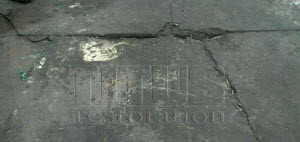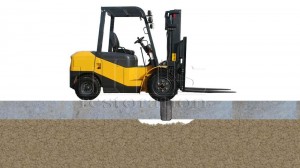Is the concrete floor in your plant causing you problems and slowing you down? Often plant managers are plagued by issues with the concrete slab, one of these issues is cracking, sinking, and unstable concrete. Structurally, these slabs have issues that need to be addressed, but their solutions may not be as impossible as you think.
 Sub-slab voids cause cracking, sinking, and unstable concrete.
Sub-slab voids cause cracking, sinking, and unstable concrete.
Voids occur beneath concrete slabs due to poor soils, sub-bases, and heavy loads. Sometimes it is an issue with drainage and water content that loosens the soil’s compaction. However, there are products and procedures that can address these sub-slab voids and correct your warehouse’s concrete floors.
When structural cracking begins it is usually a sign of settling beneath the concrete slab, however, these cracks can turn into craters and become a serious danger to your operation. Consulting with a geo-technical engineer might be the first place to turn to. They can probe the soils and sub-bases beneath the concrete and determine the underlying cause of the cracking, sinking, and unstable concrete. Once determined, remedial action can occur.
Remedies for sinking concrete and sub slab voids
1. Sub Slab Foam Injections – This process includes injecting any voids beneath and within the slab that are causing slab cracking with high density, polyurethane foam to support it under high traffic conditions. It is done by drilling consecutive holes through the concrete of the affected area and pumping them full of the high-strength, fast-curing materials until the slabs are even again. This foam is light weight and will not further compact the soils.
2. Slab Stabilizing Devices – To further remedy slab movement and future cracking, joint stabilization devices are installed to lock in the foam injects and patch materials and stop movement. These mechanical devices put extreme pressure against the slabs, holding them together. If at any time they loosen, they can be re-tightened.

Slab with Joint Saver
3. Sub Slab Soil Injections – Similar to the sub slab injections, these injections permeate loose soils where water has caused air pockets and voids. Sealing these channels of air prevents moisture from further weakening the soil and causing concrete failures.
4. Cosmetic and Lasting Surface Repairs – Once the underlying causes have been corrected, the surface of the concrete may still need to be addressed. Large divots, deteriorated joints, and “craters” need to be addressed to restore smooth transition concrete. A rebuild of the concrete can be performed with industrial strength products that will create a lasting fix for the concrete floor.

